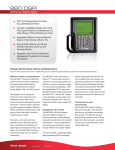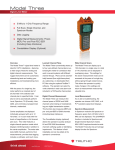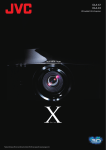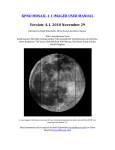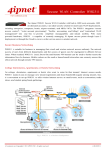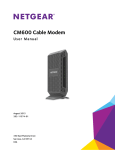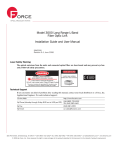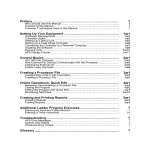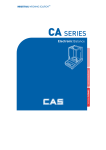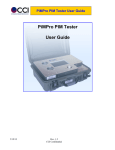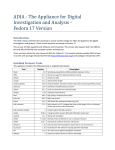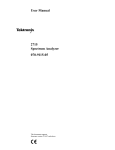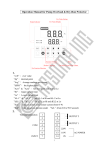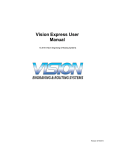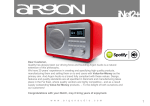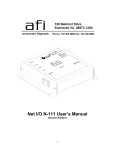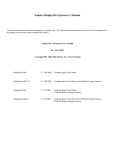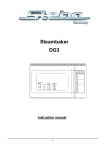Download downloaded
Transcript
Guardian System II Return Path Monitoring ■■ Complete Return Alignment, Monitoring and Ingress Troubleshooting System ■■ Supports Both Field Operations and Real-time NOC Operations ■■ Hardware, Software Components Easy to Integrate ■■ Simple to Use ■■ Extremely Cost-Effective in All Configurations ■■ DSP Technology Captures Fast Transient Impulse Noise and Ingress A VoIP Imperative Guardian System II™ is an integrated system of hardware and software that supports all return path maintenance activities, from installation testing, to distribution system alignment and ingress control, to ingress monitoring and real-time, NOClevel troubleshooting. All elements of Guardian II are closely linked for maximum efficiency, flexibility, and optimum cost-effectiveness. Monitoring the return band with DSP technology enables capture of fast transient impulse noise and ingress, as well as visibility of interfering signals beneath service carriers using unique TraffiControl feature. Installation The Guardian RSVP²™ installer’s return tester has become the industry standard for preventing return path installation problems, with many thousands in daily use. Communicating with a 9581 SST™ in the head-end, the RSVP² verifies both the transmission level from the house and the carrier/ think ahead www.trilithic.com (ingress+noise) ratio of the entire path from home to hub. Fast and very simple to use, RSVP² remains the only installation tester with sufficient measurement range to insure trouble free return services. An expanded version of the RSVP², option VP-1, is also available in the 860 DSP™ signal analyzer. The VP-1 simultaneously tests the performance of up to eight frequencies and assigns to each its individual pass or fail rating. Distribution Alignment and Ingress Control Working with an 9581 SST in the hub, the 9580 SSR™ displays errors in amplifier gain and tilt both as a graph and as calculated values. The SSR also displays the return ingress spectrum, as scanned by the SST, as an aid for troubleshooting ingress. SSR functions are also available in the 860 DSP signal analyzer, option SR-1, with additional capabilities including a screen that compares the ingress seen by the SST with the ingress at the field connection point, in real-time. 1-800-TRILITHIC Guardian System II Return Path Monitoring Diagnostic Operations Viewer II™ software gives the operator considerable flexibility in servicing SNMP traps from 9581 SSTs displaying spectra for viewing and analysis and managing the heavy flow of alarm traffic typical of a busy NOC. Node topology can be organized by geography, facilities and services, and even by maintenance organization. Viewer II enables the operator to select from a wide range of resolution bandwidths, frequency spans, detector types, and other functions needed for efficient trouble shooting. Spectrum Capture Speed: Rescan rate: all nodes rescanned 40 to 120 times per second Communications: Forward data carriers to field units. Ethernet with ECM communications option; built-in SNMP agent transmits up to 8 different trap sets to up to 8 servers running Viewer II or other management applications. RSVP² Installer’s Reverse Tester 860 DSPi Signal Analyzer ■■ Multifunction installation, signal ■■ ■■ KEY ELEMENTS OF THE GUARDIAN SYSTEM II 9581 SST Return Path Analyzer ■■ Simple automated tool for insuring ■■ Scans return spectrum, tests ingress against user defined limits, issues SNMP traps, provides live analytical data in several simultaneous formats to the field and to network operators. Extremely fast, the 9581 SST: scans each node in under 100 microseconds and rescans all nodes up to 120 times per second; analyzes reverse test signals from field units and supplies sweep, ranging, and spectral data to field technicians; and compresses spectral data for historical analysis. The TraffiControl™ function enables viewing of ingress normally hidden in upstream traffic. ■■ quality of reverse installations. Conducts ingress and ranging level tests on a selected frequency, gives PASS/FAIL and measurement data in seconds. Works with both legacy 9580 SST and 9581 SST Return Path. Operating Frequency: Single frequency: 5 to 42 MHz, settable at SST in 100 kHz steps Return Transmit Test Range: 20 to 55 dBmV Max C/(I+N) Test Range: Greater than 35 dB Frequency Range: 0.3 MHz to 65 MHz ■■ DOCSIS modem and VoIP test suites, including calculated MOS. With SR-1 option, performs reverse alignment and troubleshooting functions; additional display function showing both local ingress spectrum and spectrum downloaded from 9581 SST. With FS-1 option, performs forward sweep as part of the SpeedSweep™ system in addition to reverse alignment and troubleshooting functions of option SR-1. With option VP-1, performs the functions of the RSVP² installer’s reverse tester (above) on up to 8 frequencies. Standard Functions: ■■ Channel levels and scan ■■ Reverse spectrum scan ■■ PC substitution ■■ Modem performance ■■ MER/BER ■■ VoIP test suite (including up and downstream latency, jitter, lost and discarded packets) ■■ Computed values of MOS (mean opinion score) ■■ Auto tests (FCC Part 76 and userdefined tests) Number of Test Points: Up to 16 connections per 9581 SST think ahead ■■ analysis, and distribution maintenance analyzer from 5 to 1,000 MHz. The basic 860 DSPi includes www.trilithic.com ■■ Data logging ■■ Text browser 1-800-TRILITHIC Guardian System II Return Path Monitoring 860 DSPi Options: ■■ QA-2: Constellation diagrams: 16 QAM to 256 QAM and QPSK. ■■ SA-1: High-resolution, fullspectrum analysis: 10 kHz resolution, 5 to 1,000 MHz. ■■ VP-1: Return installation tests: Automatically tests launch Level, C/I. Tests 8 reverse frequencies simultaneously. ■■ SR-1: Reverse distribution alignment and ingress tests: Plots reverse tilt and gain, compares local and head-end ingress spectra for ingress source identification. ■■ FS-1: Forward sweep: Part of the SpeedSweep System™ that provides tests for forward frequency response. ■■ CI-3: MODEM substitution: Provides access to the internal DOCSIS modem for substitution tests or for external communication in upstream traffic. GUARDIAN II INTEGRATED SERVER PACKAGE ■■ Pre-configured server, integrating ■■ ■■ ■■ ■■ powerful software and hardware to provide a tailored, comprehensive solution for monitoring reverse and forward path HFC network spectrum, as well as various other parameters. SNMP trap handlers capture traps sent by 9581 SST R4, log them and send notification as designated. Includes extensive reporting tools for management, analysis, and node certification. In addition to Microsoft® 2003 and SQL servers, the hardware comes preconfigured with Viewer II v2.6 server software and one onboard client, as well as SST Configure software. Six additional clients are provided, standard. Viewer II v2.6 configures nodes to be monitored and viewed from tree or listing, sets RBW, span, and other parameters for spectrum displayed; allows simultaneous display of alarm or “live” spectrum with historical spectrum, limit lines or minimum/maximum/average, and TraffiControl spectrum; assembles trap logs and other databases in form that can be analyzed in Excel spreadsheets or Crystal Reports. ADIA INTEGRATED SERVER PACKAGE Analytical package for off-line analysis of historical reverse path performance data. Ideal for detecting long-term trends and availability of selected portions of return spectrum over time. ADIA analyzes ingress histories, calculates spectrum unavailability, and presents the results as “waterfall” graphs and line graphs of ingress activity over time. Bringing it all Together Guardian System II is a powerful, flexible system of field and central office products, supporting all aspects of return path management including installation, distribution system alignment and ingress control, ingress monitoring, and real-time troubleshooting. The 9581 SST, the hub of the Guardian System II, supports field technicians using Trilithic RSVP² or 860 DSPi field units and network-connected engineers using Trilithic Viewer II and ADIA software. All elements of the return maintenance process are closely linked for maximum efficiency, flexibility, and optimum costeffectiveness. 071509-REV1 think ahead www.trilithic.com 1-800-TRILITHIC Guardian II Integrated Server Package Reverse Band Monitoring Software ■■ Powerful Analysis and Report Tools for Managing Return Path Data ■■ Real-Time Diagnosis and Problem Resolution ■■ All Server Software is Pre-Installed on a High Performance Server, Ensuring Reliability and Minimizing System Activation Time The Guardian II™ Integrated Server live-view spectrum display for selected display severity thresholds. Individual Package is a pre-configured server, integrating powerful software applications and hardware to provide a tailored, comprehensive solution for monitoring reverse path spectrum. SNMP trap handlers capture SNMP traps sent by the 9581 SST™ R4s, log them to Viewer II™ v2.6, and send notification as designated. The package includes extensive reporting tools for management and analysis. In addition to Microsoft® 2003 Server and SQL Server, the server hardware comes preconfigured with Viewer II v2.6 server software, and one onboard Viewer II v2.6 client and SST Configure™ software. Six additional Viewer II v2.6 clients are provided standard. nodes. With Viewer II an operator controls 9581 SST R4s in hubs or head-ends, permitting selection of resolution bandwidths, displayed frequency span, detector modes, and other characteristics. or groups of alarms can be manually cleared (or the source of the alarms temporarily disconnected). Viewer II viewing and management software for the Guardian System II is designed to make optimum use of the broad feature sets of Trilithic monitoring equipment (9581 SST™ release 4 return path analyzer), and is used for spectrum management and troubleshooting. Viewer II displays and manages SNMP traps, with extensive reporting capability. In addition, it serves as a think ahead www.trilithic.com Ingress Alarm Management Viewer II receives SNMP alarms from 9581 SST R4s located throughout the network. Viewer II displays the incoming 9581 SST alarms with colorcoded severity in a tabular list. Alarms are also shown in a similarly color coded “tree” graph. Tabular View The tabular display presents a running list of alarms, itemized with the alarm time, type, origin (extended node name), and alarm severity. For his/her convenience, the operator can sort the alarms by any of these criteria. Viewer II includes a full set of tools for managing alarm traffic. The alarm list is automatically updated, with new listings added whenever the status of nodes is upgraded or downgraded by new traps sent by 9581 SSTs. Viewer II also allows the user to manage “alarm storms” by temporarily adjusting the 1-800-TRILITHIC Alarms can be color tagged to indicate that they have been acknowledged but not cleared. The operator can attach timers to individual alarms that will call for his attention if an alarm persists for more than a specified length of time. As an aid in determining the cause of the ingress outbreak, the operator can view recent alarm history of the selected node. Tree View The tree view presents alarms in a manner that makes it easy to determine the location of an alarm or node in the network topology. As with the tabular display, alarming nodes are color coded by severity. Guardian II Integrated Server Package Reverse Band Monitoring Software The tree view also simplifies navigation, allowing an operator to display a selected node, live, by clicking its symbol on the tree. Tree view can be expanded or collapsed as desired, with the alarm color codes following. Right clicking on either a list item or tree branch/leaf presents the operator with additional display and navigation options. The operator can reconfigure the relationships in the tree to show associations by topology, such as all nodes connected to the same CMTS blade or served by the same 9581 SST, or associated with a particular service area within the region served by the NOC. Live View Function The operator can bring up spectrum live views of one or more nodes by right clicking on a node in the tabular alarm list or in a tree view. Each live view node spectrum is updated every few hundred milliseconds, and the running maximum, minimum, and average spectra from the moment the selected spectrum was first displayed. Markers simplify accurate measurement of ingress frequencies and amplitudes. Each live view includes the node name, so several live views can be open at a time, either tiled or cascaded, without confusion. Tiled or cascaded views can be parked at convenient spots on the status monitoring screen and expanded to full live view size as needed. Any live view can be saved with all of its settings, markers values, extended node name, and a user-entered comment. The operator can adjust the settings of a live view spectrum to fit his needs, selecting frequency spans by entering think ahead www.trilithic.com either start/stop frequencies or center frequency and span, or resolution bandwidths of 30 kHz, 100kHz, 300 kHz, 1 MHz, or a special 375 KHz RBW fast transient capture mode. used in the monitoring mode, but the user can change the organization. This enables users with different areas of responsibility to see data that pertains specifically to them. The operator may select from several detector modes, including peak, average (with control over how many spectra are averaged), minimum hold, and maximum hold. A special detector function, TraffiControl™, is available in resolution bandwidths of 375 kHz. TraffiControl removes all TDMA traffic from the return spectrum, making it easier to detect ingress normally obscured by return services. Note that TraffiControl must be configured in each 9581 SST using SST Configure software. For more detailed investigation, the user can select any subset of the tree using a drill-down feature for analysis or troubleshooting. All live views can be printed. The printout includes report type, extended node ID, time and/or time frame, and values of markers (there are two) where applicable. The operator can add a comment to the printout. Recent History View Function As an aid to troubleshooting, the operator can bring up summaries of recent spectra for any selected node. This function provides 15 records, each representing one minute, altogether spanning the most recent 15 minutes. Reports Viewer II v2.6 has enhanced reporting capability that enables a system health overview and the ability to drill down for more detailed information. Organization trees can be used to group nodes as desired (reporting area). These trees may be the same 1-800-TRILITHIC To determine if ingress is time/date specific, the user can set a time or time interval of interest to further enhance troubleshooting ability. The user can select a desired alarm threshold(s) to determine which nodes have the highest number of alarm incidents, or select a percentage of node unavailability to include the duration of the incidents in the analysis. The database allows user definable attribute fields to be attached to a node and later used in reports. A report can be sorted by these attributes. The number of VoIP subscribers for each node can be added, for instance. To concentrate troubleshooting efforts on worst cases, or those affecting the highest number of subscribers, the user can restrict the report to a certain number of nodes at each level (top 10, for example). The user can view report data in tabular form, and in some cases the data can be graphed to make analysis easier. User defined reports can be saved. Reports can be scheduled to run at night, or at low traffic times to manage computer resources. Guardian II Integrated Server Package Reverse Band Monitoring Software Bringing It All Together The Guardian System II is a powerful, flexible system of field and central office products supporting all aspects of return path management, including installation, distribution system alignment and ingress control, ingress monitoring, and real-time troubleshooting. The 9581 SST, the hub of the Guardian System II, supports field technicians using Trilithic RSVP²™ and 860 DSP™ field units and networkconnected engineers using Trilithic Viewer II and ADIA™ software. All elements of the return maintenance process are closely linked for maximum efficiency, flexibility and optimum cost effectiveness. INTEGRATED SOFTWARE SPECIFICATIONS Microsoft Windows® 2003 Server A comprehensive, integrated, and dependable server platform designed to reduce costs and increase the efficiency and effectiveness of computing operations. Microsoft SQL® Server More than a relational database management system; it is a complete database and analysis product that meets the scalability and reliability requirements of the most demanding enterprises. Viewer II Server/Client Viewing and management software designed to make optimum use of the broad feature sets of Trilithic’s monitoring equipment (9581 SST return path analyzer), and is used for spectrum management and troubleshooting. SST Configure software Configures 9581 SST for network access, monitoring and field unit support. HARDWARE SPECIFICATIONS Specially-Configured Dell PowerEdge® 2U Rack Mount Server Storage Supports 1 year of data for 3,000 nodes Warranty Next business day, parts and labor with on-site response – 3 years (from Dell) A second power supply is available from Dell to provide redundancy and extra reliability. A backup storage system is recommended for prevention of data loss. think ahead www.trilithic.com 1-800-TRILITHIC Guardian II Integrated Server Package Reverse Band Monitoring Software ORDERING INFORMATION Guardian II Integrated Server Package Part Number 2011009100 Description Preconfigured server including Viewer II, one onboard Viewer II client plus six additional Viewer II clients, and SST Configure software Optional Accessories One Additional Viewer II Client License Six Additional Viewer II Client Licenses P/N 0930098100 P/N 0930098106 012609-REV1 think ahead www.trilithic.com 1-800-TRILITHIC 9581 SST Return Path Analyzer ■■ Catch “Bursty” Ingress and Impulse Noise Interference to Voice Services with Extremely High Spectrum Acquisition Speed ■■ Manage Service Quality Efficiently with 24/7 Monitoring and Configurable SNMP Alarms ■■ Align and Troubleshoot Reverse Path Quickly and Easily, and Cost-Effectively Consolidate Installation and Network Maintenance Support Equipment in the Head-End ■■ Scalable and Cost-Effective in Every Configuration The 9581 SST™ is the hub of the Guardian System II™ for return path maintenance; providing installation, reverse sweep, and ingress spectrum information to field technicians using Trilithic’s field units. When used in a Guardian System II, the 9581 SST shares spectrum information with the monitoring facility and the field units, speeding up problem identification and shortening repair times. The 9581 SST monitors the return band, generates SNMP traps, and relays monitored data to NOCs and designated network engineers. Extremely flexible, each SST supports up to twelve distribution technicians and a virtually unlimited number of installers. It can provide live spectrum information and recent historical data to as many as eight independent monitoring sites, each using its own SNMP trap criteria. Traps sent to each of these sites can be configured for different ingress severity alarm limits and persistence. think ahead www.trilithic.com Ability to Capture all Types of Ingress Cutting-edge DSP technology gives the 9581 SST unmatched power for capturing all types of ingress, including the short bursts that degrade VoIP services. Up to 100 times faster than analog-based analyzers, the 9581 SST captures and analyzes the entire spectrum of all connected nodes in microseconds and re-scans them up to 120 times per second. Thanks to the 9581 SST’s unmatched scanning speed and high re-scan rate, the NOC operator or field technician never misses an ingress outbreak capable of disrupting return services. Features a Wide Selection of Operating Modes A wide selection of operating modes makes the 9581 SST a highly versatile return path troubleshooting aid. Through the Viewer II™ software, the operator can view node spectrum information at resolutions from 30 kHz to 3 MHz to facilitate troubleshooting. 1-800-TRILITHIC The operator can also select averaging and continuously running maximum and minimum functions to diagnose immediate problems and long-term performance issues. TraffiControl™, a data processing mode unique to the 9581 SST, lets the operator analyze ingress hidden inside occupied frequency bands. TraffiControl automatically removes all legitimate TDMA signals from the displayed spectrum, leaving an easily analyzed spectrum composed solely of noise and ingress. 9581 SST Return Path Analyzer Versatile, Flexible, and Scalable The 9581 SST simultaneously supports: ■■ Installation tests ■■ Distribution sweep and maintenance ■■ Return path performance monitoring Fast and Accurate Installations The RSVP² Installer’s return tester and 860 DSPi™ field analyzer with the VP-1 option analyze data from the 9581 SST to evaluate the reverse power level and C/(N+I) from the subscriber to the head-end. Each 9581 SST can: ■■ Support up to 16 individual nodes ■■ Support up to 12 distribution technicians ■■ Support dozens of installers ■■ Send traps and live spectrum data to as many as eight server sites Efficient Distribution Maintenance The 9581 SST transmits sweep and return spectrum information to 860 DSP™ Field Analyzers and RSVP²™ installation testers, updating all field displays every 0.8 seconds regardless of the number of instruments being supported. Superior Return Monitoring When used with Viewer II monitoring software, the 9581 SST can dispatch traps to as many as eight servers, each provided with its own SNMP trap criteria. Each client user has independent selection of display resolution and may choose any available detector settings without interference to other users or loss of speed. The Guardian System II The Guardian System II is a powerful, flexible system of field and central office products, supporting all aspects of return path management, including installation, distribution system alignment, ingress control, ingress monitoring, and real-time troubleshooting. All elements of the return maintenance process are closely linked for maximum efficiency, flexibility and optimum cost-effectiveness. General Specifications Standard Connection 2 test ports Optional Connections Add 1 TPM-8 module: 9 test points Add 2 TPM-8 modules: 16 test points Each test point is analyzed individually Functions Simultaneously Supported Reverse sweep, working with 9580 SSR field units or 860 DSP signal analyzer with Option SR-1 Reverse installation testing, working with RSVP² installer’s reverse tester or 860 DSP signal analyzer with option VP-1 Reverse path ingress monitoring with SNMP alarms compatible with Viewer II software Measurement Refresh Speed Field equipment: Every 0.8 seconds Monitoring and alarming: Every 0.4 seconds Live-viewing functions: Every 0.4 seconds think ahead www.trilithic.com 1-800-TRILITHIC 9581 SST Return Path Analyzer Spectrum Data Resolution (RBW) Network Applications 30 kHz, 100 kHz, 300 kHz, 375 kHz, 3 MHz Field Applications 375 kHz Transient Troubleshooter Mode 300 kHz at high scan rate Display Range 50 dB dynamic range, 1 dB measurement resolution Level Accuracy ±1 dB Spectrum Processing Modes (Available simultaneously) Peak Mode Single spectrum comprised of the peak values of 16 to 32 spectrum scans collected during the previous 0.4 seconds AVG Mode Single spectrum averaging the 16 the 32 spectrum scans collected during the previous 0.4 seconds TraffiControl Mode Processes return spectra to remove all TDMA traffic to enhance ingress detection Updates every 0.4 seconds Spectrum Scan Rate ENM Mode Supports both network and field applications: scans all test points at rate of 40 scans per second SFM Mode Supports only transient monitoring and analysis functions: scans all test points at rate of 120 scans per second Field Unit Support Field Functions Supported think ahead Spectrum view: 0.3 to 65 MHz Current node is automatically selected or user may select other nodes supported by the same SST. Sweep: 0.3 to 65 MHz Up to 12 field units independently supported per SST. Ranging test for installation verification. Typically supports 50 or more RSVP² reverse installer’s tester or 860 DSP with option VP-1, per SST. www.trilithic.com 1-800-TRILITHIC 9581 SST Return Path Analyzer Field Communications Data Carrier 1 telemetry carrier for each 8 test points Data Carrier Frequency Set Ranges 50.00 to 53.75 MHz and 70.00 to 75.75 MHz; or 80.5 to 92 MHz Setting range is specified at time of order Data Carrier Frequency Resolution Center frequency is user-settable in 50 kHz steps Data Carrier Occupied Bandwidth 150 kHz at -20 dB 475 kHz at -60 dB Network Support Communications 10 Mbit/second Ethernet LAN connection (requires optional communications interface) 9581 SST functions as mini-server supporting up to 6 simultaneous users, each with a unique user name Data Available per Test Point Live spectrum scans, all detector modes Last ingress-affected spectrum Last test results versus 4 amplitude limit sets, user-settable persistence threshold Running, long-term maximum and minimum spectra (restartable by user) Peak, minimum, and average spectrum data compressions for last 30 minutes Includes the following: SST Configure™ software P/N 0930105000 ADIA™ software P/N 2011093100 Guardian System II software P/N 2011009100 A/C power line User’s manual Optional Accessories: I/O-7 TPX data cable P/N 2071112000 I/O-10 NCM-4 data cable P/N 2071119001 Mechanical, Miscellaneous SST Display Panel 1.5” x 2.75” backlit LCD (38mm x 70mm) Controls Tactile key pad Dimensions (H x W x D) 3.5” x 17” x 12.3” (89mm x 432mm x 312mm) Weight 7 lbs (3.18 Kg) Power 95 to 240 VAC, 50 to 60 Hz 012309-REV1 think ahead www.trilithic.com 1-800-TRILITHIC Viewer II Return Path Management Software ■■ Powerful Operating Tools for Managing Return Path Data ■■ Real-time Diagnosis and Problem Resolution ■■ Detailed Logs and Activity Summaries ■■ Easy to Integrate, Simple to Use Trilithic’s Viewer II™ software package is a comprehensive viewing and trap management program specifically designed for ingress management and troubleshooting in large territories overseen by a NOC (network operations center). Available exclusively on the Guardian II™ integrated server package, the program is designed to optimize and enhance the performance of the Trilithic Guardian II return path maintenance system, particularly the 9581 SST™, release 4 return path analyzer. Viewer II allows the operator to display, sort, and manage SNMP traps and to see a live-view display that shows the current spectra of selected nodes. It also enables the operator to select resolution bandwidths, displayed frequency span, detector modes and other characteristics for 9581 SST-R4 units in the hubs or head-ends. Incident Manager to Track Node Ingress When node ingress is detected, Viewer II automatically creates and manages an incident for the node, allowing the problem to be monitored and tracked until it is resolved. The incident think ahead www.trilithic.com manager allows users to prioritize and filter ingress problems by several criteria and, when used in a group management environment, allows each incident to be assigned to the appropriate user for resolution. Element Manager for Structured Viewing of Nodes The element manager allows nodes to be organized into any number of logical tree-type representations called element views. Elements can be structured to provide a quick view into the status of the entire system, or of selected parts of the cable network. Element trees can be created to represent any desired configuration. For example: by geographical location, hub, CMTS blade, service technician or power supply. Node View The current spectrum, status, and recent history of any node may be viewed graphically in the node view. Node view includes the current node spectrum, more than 30 minutes of historical spectrum, and up to 1000 of the most recent threshold alarm spectrum. Any number of node views may be opened and displayed at once. 1-800-TRILITHIC Chronological Event History List Viewer II displays a chronological list of all ingress alarms generated by the 9581 SST hardware. When node ingress levels reach any of the user-defined thresholds, Viewer II logs an entry into the event history list indicating the location and severity of the violation. Reporting Viewer II reporting services allow users to quickly generate detailed or summarized reports to assist in the recording and trending of node histories and performance. Reports may be printed or exported to several popular file formats. Viewer II Return Path Management Software Specifications Integrated Software Specifications Microsoft Windows® 2003 Server A comprehensive, integrated, and dependable server platform designed to reduce costs and increase the efficiency and effectiveness of computing operations. Microsoft SQL® Server More than a relational database management system; it is a complete database and analysis product that meets the scalability and reliability requirements of the most demanding enterprises. Viewer II Server/Client Viewing and management software designed to make optimum use of the broad feature sets of Trilithic monitoring equipment (9581 SST-R4 return path analyzer), and is used for spectrum management and troubleshooting. SST Configure Software Configures 9581 SST for network access, monitoring and field unit support. Hardware Specifications - Specially Configured Dell PowerEdge® 2U Rack Mount Server Storage Supports one year of data for 3,000 nodes Warranty Next business day, parts and labor On-site response – 3 years (from Dell) Ordering Information - Guardian II Integrated Server Package Part Number 2011009100 Includes the Following Optional Accessories Pre-configured server including Viewer II, one onboard Viewer II client plus six additional Viewer II clients, and SST Configure software Optional Accessories One Additional Viewer II Client License P/N 0930098100 Six Additional Viewer II Client Licenses P/N 0930098106 012909-REV1 think ahead www.trilithic.com 1-800-TRILITHIC ADIA INTEGRATED SERVER PACKAGE Historical Data Analysis Software ■■ Powerful and Complete Return Path Spectrum Data Analysis and Reporting ■■ Identify Trends with Measurable Node Performance and History ■■ Manage Technical Operations Support with Clear Problem Node Identification, Reporting and Accountability ■■ Unmatched Flexibility and Ease of Use The ADIA™ integrated server package is a pre-configured server, integrating powerful software applications and hardware to provide a tailored, comprehensive solution for managing return path spectrum data. In addition to Microsoft® 2003 Server and SQL Server, the server hardware comes preconfigured with ADIA server software. The ADIA analysis server provides all of the recommended tools, as specified in the NCTA Standard Practices¹, for evaluating a return path in terms of performance to limits and for tracking changes in performance over time. Using Trilithic’s ADIA engineers can quickly determine, over specified intervals within selectable frequency ranges and bands: ADIA is an ingress analysis server application, specifically designed for convenient and efficient historical analysis of upstream performance over periods as long as a year. ADIA collects summarized ingress data from Guardian System II™ installations in hubs and head-end, building a database that can be used for analysis of: ■■ Live Spectrum ■■ Persistence and severity of ingress outbreaks over time ■■ Recurring and long-term ■■ ■■ intermittent ingress problems on selected nodes Suitability of frequencies and bands to carry services The statistical likelihood of disturbances in any portion of the measured spectrum ■■ ■■ Shows up to four curves at a time of the current activity on the node or nodes that you have selected. Historical Spectrum Displays the maximum, minimum and average levels for all frequencies between 375 kHz and 65 MHz. Over Limit By Frequency Calculates the DISP as the percent of threshold violations for each of the four user thresholds for each time increment. In addition to specific frequency discrete ingress probability, this function allows analysis to be performed in userselectable bandwidths. ¹ NCTA recommended practices for cable television systems, supplement on upstream transport issues, 10/97 think ahead www.trilithic.com 1-800-TRILITHIC ■■ Ingress Threshold Probability ■■ Plots percentage unavailability versus frequency and threshold for each frequency over a user specified time period. Average Over Limit (ADISP) Calculates the average probability that a node will exceed its thresholds over a user-specified time interval. The ADISP is useful as a “figure of merit” test for a node’s overall performance. ADIA INTEGRATED SERVER PACKAGE Historical Data Analysis Software Integrated Software Specifications Microsoft Windows® 2003 Server A comprehensive, integrated, and dependable server platform designed to reduce costs and increase the efficiency and effectiveness of computing operations. Microsoft SQL® Server More than a relational database management system; it is a complete database and analysis product that meets the scalability and reliability requirements of the most demanding enterprises. ADIA Software Integrating powerful software and hardware to provide tailored, comprehensive solution for managing return path spectrum data. Over Limit by Frequency analyzes all data points during a specified time interval and for a specified frequency range. It displays the percentage of time that some frequency experienced ingress activity above your specified thresholds. HARDWARE SPECIFICATIONS Specially-Configured Dell PowerEdge® 2U Rack Mount Server Average Over Limit averages all data points during the specified interval and displays the percentage of time during that given interval that the four thresholds were broken. Storage Supports one year of data for 3,000 nodes Warranty Next business day, parts and labor On-site response: 3 years (from Dell) A second power supply is available from Dell to provide redundancy and extra reliability. A backup storage system is recommended for prevention of data loss. ORDERING INFORMATION ADIA Integrated Server Package Part Number 2011093100 Includes the following optional accessories Preconfigured server including ADIA history analysis 6 additional passwords Ingress Threshold Probability shows the percentage of time when a node crossed a threshold, by frequency. 012609-REV1 think ahead www.trilithic.com 1-800-TRILITHIC 8300 FST Forward Speed Sweep Transmitter ■■ Forward SpeedSweep Transmitter ■■ Fast Sweep Update, Even with High Concentration of Digital Channels ■■ Measures Active System Carriers Plus Injected Sweep to Obtain High Sweep Frequency Resolution, Especially Digital Carriers ■■ Complete Plant Maintenance Solution for 860 Field Analyzers ■■ Comprehensive Best-in-Class Measurement Functionality in a Sweep-Capable Meter The 8300 FST™ Forward SpeedSweep Transmitter is an essential part of the system for comprehensive sweep capability in the 860 DSP™ field analyzer family. The instrument is rack-mounted in the head-end, and generates a sweep that steps around system carriers to avoid interference, filling in vacant spectrum areas for a complete view of the network frequency response. The 860 DSP (with FS-1 option) receives the sweep, and based on the measured sweep and system carrier levels, plots the frequency response. The response is compared to a stored reference to provide a difference display. With the goal of the network design being unity gain from amplifier output to amplifier output, the ideal response will be as flat as possible. The sweep test provides a measure of the RF transmission characteristics of the network between the transmitter and the receiver, and is used as a day-to-day maintenance tool for the RF portion of the HFC network. think ahead www.trilithic.com Trilithic’s SpeedSweep solution includes: ■■ The 8300 FST that generates a sweep stimulus for the downstream measurement. ■■ The 860 DSP with a sweep option (FR-1) that receives the forward sweep and transmits reverse sweep signals for upstream measurements. ■■ The 9581 RSA™ (a 9581 SST™ with a narrowed sweep/alignment application orientation) to receive the upstream sweep signal generated by the 860 DSP or RSVP²™ field unit, and then relay the measurement results back to the field unit generating the signal. The 8300 FST generates a sweep that is received by an 860 DSP (with FR-1 option). This option enables the technician to test both forward and return frequency response. The transmitter is part of the “distribution” products category and is considered an essential tool for plant maintenance. 1-800-TRILITHIC The transmitter will be located in the headend, and combined with other network signals. The technician will establish a test normalization reference response at the node or at a sweep test point in the head-end after the combining network, designed to match levels at amplifier/node output test points. 8300 FST Forward Speed Sweep Transmitter Specifications RF Specifications Frequency Range 47 to 1,000 MHz; 250 kHz resolution RF Output Level Rear panel adjustment, 46 dBmV to 58 dBmV (typical) Accuracy/Stability ±5 kHz Spurious Output >60 dB (typical) Out-of-Band C/N Ratio >80 dB Includes the following: Rack-mounted 6 MHz forward sweep transmitter External Features Front Panel Controls Reset button Front Panel LEDs RF on, power/error Rear Panel Connectors, Controls F-type connectors for RF output / RF test point Serial data connector for setup RJ-45 Ethernet connector RF output level control General Power Supply Universal 90 VAC to 240 VAC, 50 to 60 Hz with IEC 320 power connector Power Consumption <30 Watts Physical Size (H x W x D) 1.75” x 19” x 12” (44mm x 483mm x 305mm) 1U rack mount Weight 10 lbs (4536 g) 010709-REV1 think ahead www.trilithic.com 1-800-TRILITHIC RSVP² Installer’s Reverse Path Tester ■■ Eliminates Callback Truck Rolls By Ensuring Installation Quality on the First Visit ■■ Verifies Operation Headroom for Critical Digital Services ■■ Quick, Simple, Automated Testing with Pass/Fail Results ■■ Small, Rugged, Lightweight and Simple-to-Use The Guardian RSVP²™ ensures return quality where it is most critical – the subscriber’s installation. Most return path problems begin in the subscriber’s home. Errors in installation, defective cabling, or incorrectly installed or loose hardware can all disrupt return path communications or allow ingress to enter the cable system. The RSVP² tests the key return parameters that verify the installation is error-free and ready for the demands of VOD, VoIP and HSD return services. Return Path Tests: Quick, Sure and Easy Pressing the “Test” button opens communications with a Guardian 9581 SST™ Reverse Path Analyzer in the hub or head-end. Automatic measurements quickly measure the required upstream transmit level and compute the carrier/(noise + ingress) ratio for the path between the subscriber and the 9581 SST. The RSVP² compares the results of both tests to user-settable limits and in seconds displays a simple, unambiguous “pass” or “fail.” The installer can also view the actual measurement data as an aid to troubleshooting. think ahead www.trilithic.com The Importance of Measurement Range Only the RSVP² / 9581 SST combination provides the ingress measurement range needed to ensure reliable HSD, VOD, and VoIP services under all conditions. Complaint-free return services require a C/(N+I) ratio of better than 25 dB in all conditions. Installations done during the workday must include sufficient ingress margin to meet mid-evening conditions when the ingress can be 6 dB worse. Of all available return path measurement systems, only the Guardian RSVP² tests C/(N+I) with the range needed to ensure trouble-free service. And it does it with a simple Pass/Fail test that can Fast Return Path Performance Testing The RSVP² performs measurements and analysis in seconds. Operation is automatic. The installer simply presses the START button and the RSVP² does the rest. be performed in seconds. The RSVP² is small, rugged, and very inexpensive, making it ideal for the installer’s tasks and environment. Built-in Test Generator for Identifying Drops The RSVP² includes a tone modulated signal source for identifying cables in MDUs and other installations. Output is settable in both frequency and level. The source may be used continuously for up to five hours on a single charge. 1-800-TRILITHIC Consistent Measurements The RSVP² evaluates upstream level and C/(N+I) measurements against settable limits and delivers an unambiguous result. Using the ConfigR Setup™ application, an operator can pre-program the operating parameters to ensure consistent installation quality. Very Cost effective RSVP² Installer’s Reverse Path Tester The Guardian System II™ The Guardian System II is a powerful, flexible system of field and central office products supporting all aspects of return path management, including installation, distribution system alignment, ingress control, ingress monitoring, and real-time troubleshooting. The 9581 SST, the hub of the system, supports field technicians using the RSVP² and 860 DSPi™ field units and network engineers using the Viewer II™ server. All elements of the return maintenance process are closely linked for maximum efficiency, flexibility, and optimum cost effectiveness. Includes the following: 50 to 53.75 MHz / 70 to 75.75 MHz reverse path tester (P/N 2010814010) or 80.5 to 92 MHz reverse path tester (P/N 2010814011) CC-15 padded carrying case P/N 2130673000 Battery charger P/N 0610150000 User’s manual on CD Specifications Test Functions Transmit Level 20 to 55 dBmV Return C/(N+I) Ratio ≥35 dB for ≥0 dBmV input to SST Output Test Signals Test Mode Used in transmit level test Single frequency 5 to 42 MHz, automatically set by transmission from 9580 or 9581 SST Source Mode Used with an SLM to ring out cabling 5 to 42 MHz, 20 to 55 dBmV, user-settable CW, tone and channel tagged output Mode Transmit Level Accuracy (All Modes) ±1.5 dB @ -18° to +55° C (0° to 131° F) Data Carrier Frequency Choose from: 50.00 to 53.75 or 70.00 to 75.75 MHz, user-settable Optional: 80.5 to 92 MHz Data Carrier Receive Range -15 to +20 dBmV Display 4 digit LED with annunciators Charger 115 VAC charger Charge Time 14 hours, maximum Operating Temperature -18° to +55° C (0° to 131° F) Dimensions (H x W x D) 4.0” x 5.0” x 1.25” (102mm x 127mm x 32mm) Weight 1 lb (454 g) Optional accessories: ConfigR software with I/O-6 data cable P/N 0930018000 F-type push-on adaptors P/N 0200622000 I/O-6 data cable P/N 2071082000 I/O-15 precision test cable P/N 2071527048 CC-15 padded cloth carrying case P/N 2130673000 011409-REV1 think ahead www.trilithic.com 1-800-TRILITHIC I-Stop Reverse Test Probe ■■ Taps Unused KS Ports For Bidirectional Measurements ■■ Compatible With SLMs, Reverse and Forward Path Analyzers ■■ Enables Tracking Reverse Ingress to the Nearest Tap ■■ Protects Instruments From Damage Caused by Excessive Line Power Introducing the I-Stop™ Reverse Test Probe The I-Stop reverse test probe is a test accessory designed for use with: ■■ Most signal level meters ■■ Trilithic’s 8821Q-R™ ■■ Trilithic’s 860 DSP™ Screw the probe into a distribution tap’s unused KS port and a spring-loaded “stinger” connects a 20 dB resistive test point circuit to the seizure screw. The connection is bidirectional, so that an SLM or analyzer connected to the probe can measure forward and reverse signals, as well as reverse ingress. A built-in AC/DC blocking circuit protects the SLM or analyzer from damage from online power up to 90 Volts. Track Down Ingress Fast The I-Stop probe also contains a patented circuit that is used with Trilithic’s Guardian System II™ return path maintenance system to track reverse ingress sources down to the nearest tap. Using the I-Stop probe, the Guardian System II, and this simple test, you can locate all ingress sources down to the tap without removing reverse pads or diplexers and without disrupting forward or reverse service. Simply screw the probe into a KS port on the distribution tap, connect the 9580 SSR field unit or 860 DSP to the test port, then press the button on the side of the probe. If the ingress displayed decreases by 4 to 6 dB when the button is pressed, the source of the ingress is farther from the node than you are. Ingress that doesn’t decrease is entering the system nearer to the node than you are. The I-Stop probe has little or no visible effect on forward path signals. Specifications Insertion Loss <1 dB, 5 to 50 MHz <3.5 dB, 50 to 750 MHz <1.5 dB, in any 150 MHz span Insertion Loss with Button Depressed ≥5 dB, ≤ 8 dB, 5 to 30 MHz ≤1 dB insertion loss increase, 54 to 750 MHz 011409-REV1 think ahead www.trilithic.com 1-800-TRILITHIC 860 DSPh Remote Head-End Analyzer ■■ 24/7 Monitoring – Catches Problems Early by Automatically Scanning Levels and other Key Parameters ■■ Issues SNMP Traps to Notify User of Problems ■■ Remote Control Lets User Take a Closer Look Without Driving to the Location ■■ Remote Access with Browser Enables Viewing Head-End or Distribution Hub Levels with Browser-Equipped Analyzer The 860 DSPh™ is the ideal instrument for managing signal quality in remote head-ends or other facilities where access is restricted or local technical personnel are not available. Based on the powerful, cost-effective 860 DSPi™ cable analyzer, the 860 DSPh provides continuous visibility of signal quality at a price that makes universal deployment practical. The 860 DSPh is programmed using WorkBench™ software to monitor various measurement parameters including channel level, depth of modulation, FM deviation, hum, carrierto-noise ratio, and MER (modulation error ratio). From a single location and using a network of 860 DSPh’s and Interrogator™ software , the operator can monitor signal quality at many sites throughout his system and be alerted to problems quickly if they occur. The 860 DSPh is typically configured to automatically monitor key parameters and log measurement data as it compares it with user-programmed think ahead www.trilithic.com limits. If a parameter falls outside of limits, the 860 DSPh can dispatch a range of SNMP (simple network management protocol) traps to multiple destinations by interfacing with Interrogator and/or OSS software. The 860 DSPh can also detect rapid changes in measurement results for a given channel and generate a warning trap. The operator may then take control of the 860 DSPh directly and use its powerful analytical tools to determine the cause of the problem. Measurements ■■ ■■ ■■ ■■ ■■ ■■ ■■ Channel level (analog and digital) Depth of modulation FM deviation Hum C/N MER BER Test Management ■■ All channel levels are given priority and measured every 30 seconds, regardless of automated test sequence. ■■ Min, max, avg, and current level 1-800-TRILITHIC saved for every channel. ■■ All other tests (C/N, depth of modulation, FM deviation, hum, and MER) are measured between channel scans. Impulse BER measurements can also be performed. SNMP Traps ■■ Sends traps on a per-channel basis ■■ Escalation/de-escalation of problem prompts new traps ■■ Timed re-send to catch alarms lost due to network conditions ■■ Traps contain all information regarding affected channel, location, and fault The 860 DSPh maintains MIB of the last readings for each test and current state of each channel, available for retrieval by Interrogator software or via the browser function of an 860 DSPi. 860 DSPh Remote Head-End Analyzer Interrogator™ Software Option ■■ Receives alarm (SNMP trap) from 860 DSPh when a channel parameter exceeds a user defined limit; adds it to event list ■■ Presents trap occurrences in tree views of deployed 860 DSPh’s ■■ Compares trap data to limits ■■ Saves trap data in database ■■ Presents live views of scans or measurement values ■■ Displays recent history scans in tabular lists ■■ Notifies via email of alarm events Specifically designed as a remote monitoring interface for the 860 DSPh, the Interrogator is an essential part of Trilithic’s remote head-end/ hub site monitoring system. When a measurement result for a channel is out of limits an SNMP trap is sent to Interrogator. Traps contain the following information: ■■ Hub name ■■ Device name ■■ Channel ■■ Alarm type (offending parameter) ■■ Offending data (sends whole channel line-up for level fault, single reading for all other alarm types) Monitoring The Interrogator displays: ■■ The trap information in an event list ■■ 860 DSPh’s and channels in a tree view ■■ A comparison of trap data to the prescribed limit ■■ A “live view” of the channel measurement parameter or function Remote Access (Web Server) ■■ Current alarms available for all channels ■■ Current channel information available for all measurements ■■ Remote access does not impact scanning speed ■■ Username/password protected The 860 DSPh maintains a MIB of last readings for each test and current state of each channel (i.e. alarm state, which changes only on a severity downgrade or upgrade). Interrogator can be configured to email alarm notifications to designated addresses. think ahead www.trilithic.com 1-800-TRILITHIC 860 DSPh Remote Head-End Analyzer Live Mode Display Examples: Channel Scan Spectrum Mode Spectrum think ahead www.trilithic.com 1-800-TRILITHIC 860 DSPh Remote Head-End Analyzer QAM, MER, BER BER Over Time think ahead www.trilithic.com 1-800-TRILITHIC 860 DSPh Remote Head-End Analyzer General Specifications Frequency Range 5 to 1,000 MHz, standard Tuned by channel Frequency specified in 25 kHz increments Channel Plans Any number of channel plans can be stored; only one per input can be active at a time (16 active channel plans of 140 channels each). Modulation Compatibility Compatible with NTSC, PAL, SECAM, signals, common scrambling formats, QPSK, and QAM signals. User-definable power bandwidth for digital signals. Monitored Parameters Signal Level Measurement Range -40 to +50 dBmV with 0.1 dB resolution Measurement Accuracy ±0.75 dB absolute @ 25˚ C (77˚ F) ±2.0 dB @ -18˚ to +50˚ C (0˚ to 122˚ F) Digital signals ± > 0.5 dB additional Hum Range 0 to 5% ± 0.5% 50/60 Hz + 100/120 Hz + 1 KHz lowpass C/N Range > 50 dB with + 10 dBmV carrier level Depth of Modulation Range 50 to 100% with 0.5% resolution FM Deviation Range ≤ 35 kHz with 1 kHz accuracy MER Modulations Supported QPSK, 16, 32, 64, 128, and 256 QAM Range -6 to +38 dB think ahead www.trilithic.com 1-800-TRILITHIC 860 DSPh Remote Head-End Analyzer Mechanical Specifications Size 1U (1.75”) Includes the following: 5 to 1,000 MHz rack-mounted analyzer (customer specified options) Weight 5 lbs maximum, with options 90 to 240 VAC U.S. plug Principle Interface Ethernet (TCP/IP, HTTP, and SNMP) Secondary Interface RS-232 38400, 8, 1, no flow control Power 90 to 240 VAC 50 to 60 Hz User’s manual Optional accessories: Input expander P/N 2011013000 WorkBench™ software P/N 0930083000 Interrogator remote head-end monitoring system software P/N 0930123000 012309-REV1 think ahead www.trilithic.com 1-800-TRILITHIC Interrogator Remote Head-End Monitoring Software ■■ Works with 860 DSPh to Monitor Downstream Analog and Digital Services ■■ Receives Out-of-Limit Alarm (SNMP trap) from 860 DSPh, Adds it to Event List and Notifies User on Screen or Via Email ■■ Intuitive User Interface Displays Trap Events and Provides a Live View of the Current Condition of the Alarming Parameter Specifically designed as a remote monitoring interface for the 860 DSPh™, the Interrogator™ is an essential part of Trilithic’s remote headend/hub site monitoring system. The 860 DSPh is programmed using WorkBench™ to monitor various measurement parameters including channel level, depth of modulation, FM deviation, hum, carrier-to-noise ratio, and MER (modulation error ratio). When a measurement result for a channel is out of limits an SNMP (simple network management protocol) trap is sent to Interrogator. Traps contain the following information: ■■ ■■ ■■ ■■ ■■ The 860 DSPh maintains a MIB of last readings for each test and current state of each channel (i.e. alarm state, which changes only on a severity downgrade or upgrade). The trap data is saved in a data base for future analysis. Monitoring Interrogator displays: ■■ The trap information in an event list ■■ 860 DSPh’s and channels in a tree view ■■ A comparison of trap data to the prescribed limit ■■ A “live view” of the channel measurement parameter or function Hub name Device name Channel Alarm type (offending parameter) Offending data (sends whole channel line-up for level fault, single reading for all other alarm types) think ahead www.trilithic.com 1-800-TRILITHIC Interrogator Remote Head-End Monitoring Software Interrogator Minimum System Requirements Processor 1 GHz Pentium-III or higher (2 GHz Pentium 4 or higher recommended) Memory 256 MB RAM Hard Drive 2 GB free disk space (or 50 MB free disk space for client-only installations) Operating System Windows® 2000, Windows® XP, or Windows® Server 2000 Display Color monitor running at 256 colors or higher 1024 x 768 minimum screen resolution Internet Connection High-speed internet connection Additional Hardware Windows®-compatible keyboard and mouse Ordering Information Product Name Interrogator software Part Number 0930123000 Related Products 860 DSPh P/N 2011006001 860 DSPh input expander P/N 2011013000 WorkBench software P/N 0930083000 012609-REV1 think ahead www.trilithic.com 1-800-TRILITHIC





























